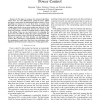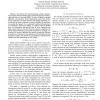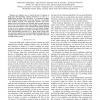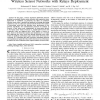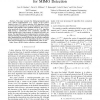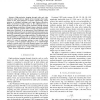ICC
2009
IEEE
15 years 7 months ago
2009
IEEE
—In this paper we propose two advanced algorithms which allow for both differentiated quality-of-service (QOS) and power conservation in input-queued packet switches. These algor...
91
Voted
ICC
2009
IEEE
15 years 7 months ago
2009
IEEE
In this paper, we propose a new analytical model for throughput evaluation of wireless network coding. This new approach is based on a probabilistic viewpoint on network coding, i....
88
Voted
ICC
2009
IEEE
15 years 7 months ago
2009
IEEE
Abstract— It is known that next generation mobile comunications systems will most likely employ multi-cell signal processing often referred to as network MIMO - in order to impro...
90
Voted
ICC
2009
IEEE
15 years 7 months ago
2009
IEEE
— A powerful path computation element is a must for the next-generation IP-over-Optical networks to support ondemand service provisioning crossing layers. The main purpose of pat...
83
Voted
ICC
2009
IEEE
15 years 7 months ago
2009
IEEE
—An efficient way to bound the size of clusters in large-scale self-organizing wireless networks is to rely on a budget-based strategy. The side effect of conventional budgetbas...
101
Voted
ICC
2009
IEEE
15 years 7 months ago
2009
IEEE
—In this paper, a binary hypothesis distributed detection problem in correlated wireless sensor networks with cooperative relays deployment is considered. In particular, the effe...
93
Voted
ICC
2009
IEEE
15 years 7 months ago
2009
IEEE
Abstract—In this paper, we propose a simple and efficient twostage list synchronizer for frame synchronization of Low-Density Parity-Check (LDPC) coded data transmitted over the...
110
click to vote
ICC
2009
IEEE
15 years 7 months ago
2009
IEEE
—This paper presents the field-programmable gate array (FPGA) implementation of a variant of the LenstraLenstra-Lov´asz (LLL) lattice reduction (LR) algorithm, known as the Cla...
91
Voted
ICC
2009
IEEE
15 years 7 months ago
2009
IEEE
— High-resolution imaging through walls and other materials using microwave signals serves amongst other applications in the rapid detection of human maneuvering, rescue missions...
97
Voted
ICC
2009
IEEE
15 years 7 months ago
2009
IEEE
Abstract— For multiple-input multiple-output (MIMO) systems, the optimum maximum likelihood (ML) detection requires tremendous complexity as the number of antennas or modulation ...
